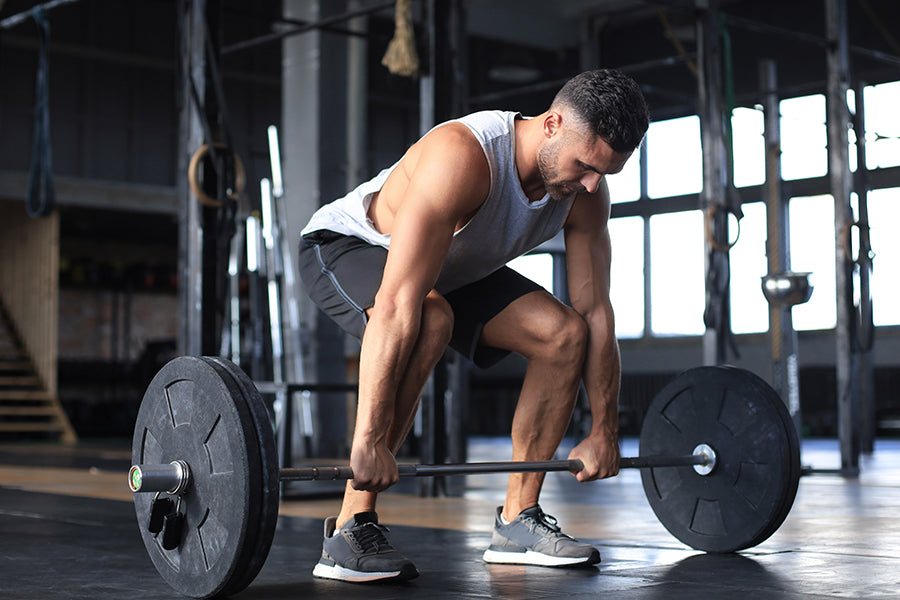Strength training can be transformative and incredibly empowering. If you’ve been mastering the squat, deadlift, and bench press and are ready to take your fitness regime to the next level, one-rep max (1RM) is an excellent indicator of the weight you should use for each exercise.
1RM is a significant number to aim for as it increases muscle mass and bone strength, improves body composition by promoting fat loss, raises flexibility levels, and reduces your chances of injuries.
This form of training enhances your physical capabilities and gives you in-depth mental strength and resilience to deal with everyday life.
So if you plan to pick 1RM as a determining factor for your training, read on to better understand what it means and how it can benefit you.
What is 1 RM?
A 1RM, or one-rep max, measures the maximum weight an individual can lift in one repetition. It is commonly used by athletes and fitness enthusiasts to monitor their strength gains over time and build muscle mass.
1RM, or one repetition maximum, is essential in weight lifting. The method is a way to determine your personal best weight that you can lift with good form a single time.
Moreover, it is used in instructions for exercise routines. For instance, "three sets of 6RM lifts," meaning you would use the weight that you can only lift with good form six times and repeat the sequence three times (three sets).
It is common to see 1RM as a percentage for exercises, like "Six reps at 75% of 1RM." If 1RM for the exercise is 20 pounds, then the instruction would be to use 15 pounds when exercising. The term allows people of different abilities to use the exact instructions as they adjust their weights according to their 1RMs.
Protocols to Follow for Performing 1RM Test
Now that you have understood what 1RM means, let’s explore how to take the 1RM test to know your strength level. It is important to note that there is a proper protocol that one should follow while testing 1RM. Here are the steps to follow:
- Start with a warm-up by picking up a light exercise that you find easy. Do 5-10 reps to prepare your body. Then, take a minute’s rest.
- Now, increase the load and pick a weight that you can do 3-5 reps easily. You can add 10 to 20 pounds for upper body lifts and 30 to 40 pounds for lower body lift to the weight you initially picked.
- Next, take a 2 minute rest.
- Now, lower the number of reps and increase the weight once more. You can perform 2 to 3 reps while adding 10 to 20 pounds to your upper body lifts and 30 to 40 pounds to your lower body lifts.
- Again, rest for a couple of minutes before repeating the same procedure of increasing the weight and decreasing the number of reps.
- Now finally, you can attempt a 1RM. If you find it difficult to do it, lessen the weight and try again. Continue adding or reducing the weight until you can do it in one go and with the correct technique.
You can also adjust this protocol for a multiple-repetition test. For example, if testing for the maximum weight you can lift 10 times — a 10RM test— is more suitable. This testing is most useful when measuring physical performance on exercises where large muscle groups and multiple joints are engaged (such as bench pressing deadlifting) or with isolation exercises that hone in on smaller muscle groups and single joints (for example, bicep curls).
Such tests are highly beneficial for athletes who wish to gain a detailed understanding of their strength levels.
Related Article: How to Calculate Your One Rep Max for Bench Press Excercise?
Tips You Should Follow While Using 1RM Strategy for Strength Training
When testing your 1RM, it’s essential to attempt the exercise with proper form and correct technique. Improper form can lead to muscle or ligament damage and should be avoided at all costs.
It’s also essential to use a spotter when testing 1RM, as it can often be difficult for an individual to put the weight back down in case of failure safely.
To accurately measure your 1RM, you must attempt the exercise with maximal effort, pushing yourself to the limit on every rep. Once you have found your 1RM, it is a valuable tool to track progress in strength gains over time. By regularly retesting your 1RM, you can ensure that you are making strength gains and gaining muscle mass.
1RM testing is also valuable for athletes as it allows them to set realistic training goals. When you know your 1RM, you can use this data as a reference point and adjust your workouts accordingly.
This can be especially helpful when tailoring a program for strength gains or muscle building. If you want to increase your 1RM, following a well-structured program with progressive overload is essential.
This will allow your muscles to become stronger and able to lift the weight in the long run. One can also use additional support such as a weightlifting belt, fat bar grips, and knee wraps to make the job easier.
Overall, 1RM testing is an important tool for athletes and fitness enthusiasts looking to gain strength or build muscle mass. By regularly retesting your 1RM, you can measure progress over time and ensure that you are pushing yourself toward achieving your goals.
With the help of a spotter and proper form, it is easy to safely measure your 1RM and use this data as a reference point for future workouts.
How Can 1RM Improve Your Workout Plans & Make Them More Efficient?
There are several benefits of using 1RM training as it requires one to increase their fitness and progress to become healthier gradually. Let’s look at some of the top advantages that 1RM strength training offers:
Improved Strength
You can significantly improve muscular strength by working with heavy weights relative to your current strength level. Working with 1RM exercises will allow you to challenge yourself and push your body further than it has ever gone before.
Increased Muscle Gain
Adding more weight during training can increase muscle hypertrophy or growth. By forcing your muscles to work harder and heavier, you can help them reach their maximum potential and achieve your desired physique.
Related Article: Weightlifting Vs. Bodyweight: Which is Better for Muscle Gain?
Improved Power Output
Working with 1RM exercises will help increase power output due to its explosive nature. This benefits those who participate in sports requiring quick movements and fast reflexes.
Improved Focus
Working with 1RM exercises will require a high level of focus and concentration. This benefits those who must stay on task and remain focused throughout their training sessions. This can help overall progress and reduce the chances of injury due to a lack of proper form or technique.
Improved Performance
You can see increased performance in any physical activity by pushing your body to its limits. Working with 1RM exercises will allow you to maximize your potential and ultimately reach the goals that you have set for yourself.
The improved strength, power output, and focus will help improve overall performance and make reaching your goals easier.
Improved Mental Toughness
Working with 1RM exercises will require great mental toughness and focus. The intense nature of the exercises can help increase your ability to stay focused under pressure, which benefits any athlete or physical activity enthusiast.
With this increased mental toughness, it will be easier for you to reach the goals that you have set and stay motivated during your journey.
Conclusion
Working with 1RM exercises can help improve strength, muscle gains, power output, focus, performance, and mental toughness. By challenging yourself with heavy weights relative to your current strength level, you can maximize your potential and achieve your desired results.
Whether you are a bodybuilder, athlete, or fitness enthusiast, 1RM exercises can be a valuable tool in helping you reach your goals and become the best version of yourself. So give it a try and challenge yourself to reach new heights!
Reading List
Article Sources
- https://www.nsca.com/contentassets/61d813865e264c6e852cadfe247eae52/nsca_training_load_chart.pdf.








